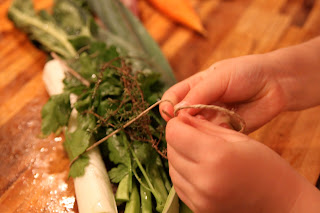I'm back with more experiments in meat-cooking. This being winter, it's good to undertaken slow-cooking projects that won't be as appetizing in the warmer months (to the extent that it gets warm at all in Paris, but that's another story).
Last weekend, my daughter and I made this very tasty French dish called a pot-au-feu, which despite its rather scary name, does not involve throwing anything into a fire. It's a slow-cooked, extremely simple beef dish that is hearty and warm and makes for great leftovers.
The premise of pot-au-feu is that if you cook vegetables and meat together long enough, you'll end up with delicious veggies, tender meat, and tasty broth, all with minimal supervision or work. Of course, it gets a little more complicated if you try to involve little hands, but that's part of the fun.
HFW has a recipe for this dish, but I didn't follow it completely, in part because my wife won't let me cook with things like beef tongue (which is a bummer, because it's yummy).
I went to the market and picked up a variety of vegetables to give the dish color, flavor, and texture.
I used the following: carrots, Jerusalem artichokes, heirloom purple carrots, turnips, parsnips, onions, black radish (that large black thing - it's white inside), and leeks.
For meat, I used cheek (leftmost below),
paleron (center), which is a piece of
chuck in American beef-cutting, and a saw-off veal leg bone for marrow (rightmost).
We had to peel all of the vegetables, and my daughter helped with the turnip. She managed it despite the turnip being quite big for her hands. It helps that we have an awesome (and safe) peeler. So awesome that we actually take it on vacation with us.
The heirloom carrots were a bit of a bust, seeing how they're just orange on the inside...
Once you've prepped, you boil the meat by itself for about 10 minutes, or until the foam becomes white. You remove all of the brown/gray foam as it forms and throw it out.
Once you've got your meat where you want it, you just throw the vegetables in, and simmer for 3-4 hours. You can't really overcook pot-au-feu, but you can under-cook it, so be on the safe side. Just be sure to add enough liquid to cover everything at the beginning and add some herbs to give the broth flavor.
Rinsing herbs in the sink is a good task for a 4 year old. I used parsley, rosemary, and thyme (no sage...) because it's what I had. For spices, I used black pepper and a couple of cloves. Of course, I put a couple of garlic cloves in as well.
Predicting, rightly, that the kids wouldn't be so keen to eat mushy turnip (all the veggies end up mushy, but that's to be expected), we also prepared some sautéed potatoes and carrots on the side. With the right supervision, and a sufficiently-sharp knife, a 4 year old can chop potatoes. In my opinion, it's safer with a sharper knife because there's less risk of slipping. Adult supervision is paramount, needless to say.
In my opinion, carrots are too hard, and therefore dangerous, for a child to chop, and so I prepared those. Spooning out lard, on the other hand, is perfect.
Learning to clean up after yourself is a fundamental cooking skill, and it's always easier if your daughter has a Cinderella obsession...
After 4 hours of cooking, you end up with a rather unimpressive dish, but it is melt-in-your-mouth delicious. In this particular case, the purple carrots lost their color and ran all over the other veggies, which all ended up with a dull purple hue - note to self: don't cook with those carrots again, unless they are by themselves or in a salad. It wasn't exactly lovely to look at, but it was mighty tasty. Serve with mustard and cornichons or pickles.
If you're like me, you'll make too much of this, and have leftovers. In the River Cottage Meat Book, HFW recommends pan frying the leftover meat in a bit of oil. I tried this and it's absolutely delicious because the fibrous meat will break down and fry fiber-by-fiber, leaving you with a crunchy treat. You can serve the leftover vegetables in the broth.
The crunchy meat is so good that I am tempted to modify the way I serve this next time: keep half of the meat in its melt-in-your-mouth soft state and fry the rest. Serve together for added texture and flavor.



















































